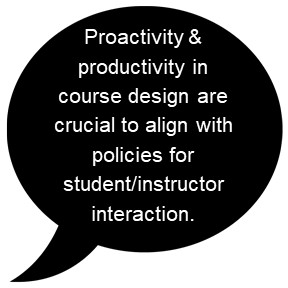Author(s): Dr. Florence Williams
Editor: Dr. Denise Lowe
Dear ADDIE,
The U.S. Department of Education (DOE) now requires that all online courses for which students may use Title IV funds (federal financial aid) include regular and substantive interaction (RSI) between students and instructors. There must be “scheduled and predictable” opportunities for instructor/student interaction in course design. As proponents of online learning design, my colleagues and I thought that we could work with any policy requirement for student access, accessibility, or interaction by leveraging innovation and delivery with design thinking. However, this need to address instructor/student interaction through course design, and the related guidance for implementation are new. Putting it bluntly, we’re stumped! Should we include the RSI in course-design consultations or share the requirement as a quality item and leave it to the faculty to create these opportunities through course facilitation?
Signed,
Stumped Proponent
Dear Stumped,
You have brought an exciting concern to the fore. As we continue into these pandemic times, faculty and instructional design relationships become more complicated. Course design often addresses in-course interaction by facilitating student engagement with the content and with each other. While the online instructor guides the process through facilitation, course design should also address scheduled and predictable instructor/student interaction opportunities. The new regulations from the DOE, which went into effect on July 1, 2021, update the definitions for correspondence education by using RSI to distinguish distance education courses for which students can utilize Title IV funds. The RSI requirements in the Online Learning Consortium (OLC), WCET (WICHE Cooperative for Educational Technologies), & University Professional and Continuing Education Association (UPCEA) (2019) report provides a broad context for consideration that is supported by the reports of the individual agencies of WCET (2020) and UPCEA (2020). In short, the consensus is that since the instructor must primarily initiate the RSI, it can best be addressed by both structured course design and quality course facilitation.

RSI includes engaging students in teaching-learning and assessment that incorporates the course content and aligns with the course learning objectives. Course design that supports RSI must provide direct instruction by presenting content in meaningful ways to meet the needs of diverse learners. Instructors must provide feedback to student queries about the content and give critical and focused feedback on their coursework and assignments. In cases where the course design includes a collaborative activity, the instructor must provide information for the group’s engagement and feedback on group tasks.
Recommendations for course design that establishes this interactive structure may include:
- Be proactive and interactive. Create opportunities for connecting with the content and instructor through active learning design. Proactively place learner considerations at the center of the design approach with opportunities for regular and consistent student interactions. Focused interactivity begins with the syllabus design in which the instructor can identify options for intentional engagement.
- Create social and collaborative engagement. Build pathways for developing an instructor-led learning community by encouraging diversity awareness and respect for the ideas and skills of others. Establish substantive discussion and engagement guidelines for students. As the instructor, engage substantively through monitoring and increased responsiveness.
- Acknowledge tensions between policies and practices. Quality assurance requires course design to foster a connection between the curriculum and compliance expectations and tie these into the course in meaningful ways. Connect students with helpful resources by incorporating institutional and departmental policies, links to learning advisors, and program or department resources.
It is crucial to be proactive and productive in the course design phase to align with the RSI policy for student/instructor interaction. Several Learning Management Systems (LMS) have built-in affordances or intelligence agents that support effective instructor-initiated course facilitation. These agents can facilitate an interaction structure for small and large courses through:
- Course assessment policies
- Incorporate practice opportunities and peer reviews
- Develop question banks for online quiz randomization
- Create rubrics and collaboration expectations
- Provide guided feedback on student coursework
- Create automated quiz (re)views that correct erroneous information, provide answers, and directions for further study
- Effective time management practices
- Message students who did not visit topics, have been absent for xxx days, have missed assignments
- Preset announcements to launch on specific dates
- Meetings and office hours
- Create appointments for whole-class engagement
- Provide regular opportunities for one-on-one meetings
What other policies or practices for incorporating regular and substantive interaction through course design have you applied or are exploring at your higher education institution? Please share your thoughts with our TOPkit community on LinkedIn!
References
Online Learning Consortium (OLC), WCET (WICHE Cooperative for Educational Technologies), & University Professional and Continuing Education Association (UPCEA). (2019). Regular and Substantive Interaction: Background, Concerns, and Guiding Principle. In Online Learning Consortium. Online Learning Consortium.
